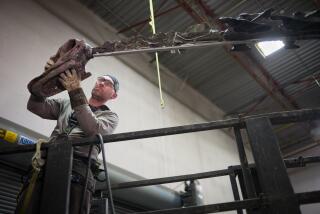Boning Up on Prehistory
- Share via
So huge, so ancient and so thoroughly otherworldly, dinosaurs have long been the subject of great public fascination. But with its latest visiting exhibit--”A T. rex Named Sue,” which opens this Saturday--the Natural History Museum of Los Angeles County believes it may have in its possession one of the most alluring dinosaur attractions ever presented.
Of the 22 Tyrannosaurus rex skeletons discovered, Sue is the largest, best-preserved and most complete. Most of the unearthed T. rex skeletons have less than 60% of their bones. Sue is about 90% complete.
In addition, this 67-million-year-old fossil is the priciest dinosaur skeleton in existence. Chicago’s Field Museum--with financial partnering from McDonald’s Corp., Walt Disney World Resort, the California State University system and private donors--purchased Sue at auction for a whopping $8.36 million. The 42-foot-long T. rex was unveiled amid much public and media attention last May at the Field Museum.
The real Sue is too large, fragile and valuable to take on the road. So what will appear at the Natural History Museum is one of two replicas of the original now touring the country, made of a plastic compound called expanding urethane.
“The casts [that make up this traveling Sue] are [molded] from the actual bones,” explains Leah Melber, a science education specialist at the Natural History Museum. “So they are identical in appearance to the real bones. A lot of times, researchers do research from a cast. What a lot of people don’t know is that when you see articulated dinosaur skeletons in museums, oftentimes they are a combination of real and cast bones. It’s almost impossible to tell the difference.”
Discovered 10 years ago in South Dakota by fossil hunter Sue Hendrickson, this celebrity T. rex has contributed valuable information to dinosaur research. Sue gives further credence to the theory that dinosaurs were related to birds. The massive skeleton includes a wishbone, something not found with previous, less complete T. rex discoveries. In addition, the markings of muscle attachments on its legs reveal that the leg muscles resembled those of birds.
Thanks in large part to funding by McDonald’s and Disney, expensive and powerful CAT scans were done of Sue’s skull. These tests indicate that T. rex had large olfactory bulbs that gave it a highly developed sense of smell. In fact, this sensory area is almost as large as the dinosaur’s entire brain.
“It must have been an awesome predator,” observes Luis Chiappe, associate curator of the department of vertebrae paleontology at the Natural History Museum. “It not only had the weapons to do it, but it also had a keen sense of smell and binocular vision. The visual fields of each eye were able to overlap, which allowed them to know exactly where their prey was located.”
A ‘Sue-Per Show’ Targets Families
The Sue exhibit, which runs until April 22, will also feature various interactive displays. Visitors will be able to look through the eyes of a T. rex and compare its depth perception with that of other dinosaurs. A “super sniffer” nose will give people a sense of how it smelled its environment. And anatomical models will allow visitors to control the movements of a T. rex’s tail, jaw and forelimbs.
Families are clearly a primary target group with this exhibit. A child-oriented musical presentation titled “Sue-Per Show” will be staged multiple times every Saturday and Sunday. Actors in simple dinosaur costumes will sing songs designed to entertain and educate young patrons about these prehistoric animals.
A 500-square-foot dig pit will include casts of dinosaur bones. Budding paleontologists will be able to dig for these pseudo-fossils using archeological instruments.
Trained fossil preparators and educators also will be on hand in the gallery. As they work on specimens, they will field questions from visitors about the process of preparing a fossil.
“Every fossil that is collected is surrounded by rock,” says Chiappe. “Therefore, there is very tedious work that a fossil preparator needs to do in cleaning the bones and removing all the rock that surrounds the bone. The bone needs to be clean for study.”
In the case of Sue, it took 10 fossil specialists two years to clean and repair the bones.
A handful of special dinosaur-related classes and programs are also scheduled at the Natural History Museum during the Sue exhibit. An open house for educators will take place the night of Nov. 28; a class for preschoolers occurs on Dec. 16; a sleepover at the museum will occur the evening of Dec. 29; a discussion with Sue Hendrickson, the fossil hunter who discovered Sue, is scheduled for Jan. 28; and two Cub Scout sleepovers and a pair of Girl Scout sleepovers are planned for the first three months of 2001.
Chiappe hopes that visitors will also appreciate the Natural History Museum’s own permanent dinosaur exhibit. He boasts that it’s the only museum that possesses a three-tiered T. rex “growth series,” which includes skulls from two juvenile and one adult T. rex.
“These are real specimens, not casts,” Chiappe notes. “People will be able to see the changes that have occurred during the life of a T. rex from an animal that, when he was an adolescent and young, had a skull that was longer and shallower, to a skull that became a lot heavier, stronger, shorter and higher. They were changes that were very likely related to feeding habits. The large adults were able to capture very large prey and to bite with greater strength.”
So was Sue worth its $8.36-million price tag? While acknowledging the skeleton’s importance, Chiappe can’t help but wonder if that money would have been better spent on field research.
“In terms of field work, the amount of work a museum could do with that amount of money is almost unprecedented,” he says. “I would say, ‘Let’s send our huge crews of dinosaur hunters into the Badlands [of the Montana-South Dakota region] and let’s let them work for 10 years.’ You will find many more Sues and many other dinosaurs. There’s no question about that. Was [purchasing Sue at that high price] good business? I would imagine the companies that purchased it would probably say, ‘Yes.’ This has been a very successful show.”
* “A T. rex Named Sue,” Natural History Museum of Los Angeles County, 900 Exposition Blvd., Exposition Park, Los Angeles. Saturday through April 22. Museum hours: 10 a.m.-5 p.m. daily. $8; ages 5-12, $2; students with ID and over age 62, $5.50; under age 5, free. (213) 763-DINO.
More to Read
Sign up for The Wild
We’ll help you find the best places to hike, bike and run, as well as the perfect silent spots for meditation and yoga.
You may occasionally receive promotional content from the Los Angeles Times.






